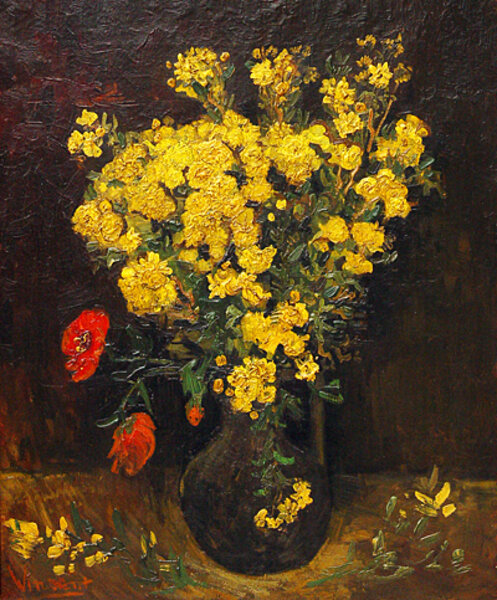The thieves had it easy in Cairo art heist
Loading...
| Cairo
When the Vincent van Gogh still life “Poppy Flowers” was stolen from Egypt’s Mahmoud Khalil museum Saturday, no one noticed at first.
None of the alarms meant to protect the artwork in the museum sounded. Only seven of 43 security cameras were working. Just 10 people visited the museum that day and guards were scarce enough that the thieves were able to drag a couch underneath the painting to stand on while cutting the $55 million painting from its frame in broad daylight.
Those are some of the security failures that Egyptian officials have pledged to address as they react with outrage to the daring heist.
The blame quickly fell on the deputy culture minister, who, as the head of the fine arts department with an office in the museum, has been charged with negligence. Four museum employees were also detained.
“I can’t work with these incompetent employees,” Culture Minister Farouk Hosni told Egyptian newspaper Al Masry Al Youm, saying he cannot sleep at night because of concerns over Egypt’s art and antiquities.
“Poppy Flowers” was hanging in the Mahmoud Khalil Museum, the former home of a 1930s Egyptian politician that now houses his collection of more than 300 paintings and 50 sculptures, including works by Claude Monet, Pierre-Auguste Renoir, Paul Gaugin, and van Gogh. Such security failures at a museum with a collection worth an estimated $1.2 billion are surprising, even in Cairo, where metal detectors are ubiquitous but seldom put to real use. (The metal detector at the Mahmoud Khalil museum was said to be broken.)
Zahi Hawas, head of Egypt’s Supreme Council of Antiquities, said in a statement Tuesday that Egypt would create a central security office to monitor its museums, and that Mr. Hosni would review museum security procedures.
Mr. Hawass is eager to keep the heist from being used as an argument against his mission to recover the ancient Egyptian artifacts held by international museums. The Ministry of Culture and the public prosecutor‘s office refused to comment on the issue. Hosni caused confusion when he falsely declared the painting recovered and the thieves apprehended at the Cairo Airport, later claiming his statement was guided by false information.
Julian Radcliffe, founder of The Art Loss Register, which maintains a database of stolen artwork, says properly protecting artwork is no simple task. It requires costly technological safeguards, such as burglar alarms and camera surveillance, and guards in every room.
“It's a very expensive and complex operation to keep security at a high level,” he says. “That does not excuse the bad security but it's not cheap and easy.”
Even before the theft, the lack of security was at the small museum was noticeable. Visitors had virtually free rein in the worn interior where many paintings, lacking a glass protectant, hung within easy reach. In most rooms, there were no guards to keep watch.
Egypt has reportedly put border patrols and airport officials on alert to prevent the painting from being smuggled out of the country. Mr. Radcliffe says the thieves will almost certainly attempt to move the painting out of Egypt to access the bigger markets in Europe and the US, if they have not already.
“They will eventually try to put it back on the market or try to get a ransom for it,” he says. “They may put it back on the market as a very good copy.” They will glean a profit even if they only receive a small percentage of its open-market value.
The chances of recovering “Poppy Flowers” quickly is slim. Only about 15 percent of stolen works of art are recovered within 20 years, says Radcliffe. According to him, about 15 to 20 percent of stolen artwork is destroyed or forgotten, while another 15 to 20 percent are sold, and yet another 15 to 20 percent “stay in the underworld for long periods of time.”
The worldwide art theft trade could be as large as $1 to $2 billion a year, according to calculations by The Art Loss Register.





